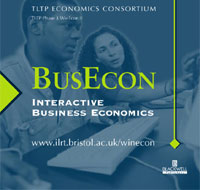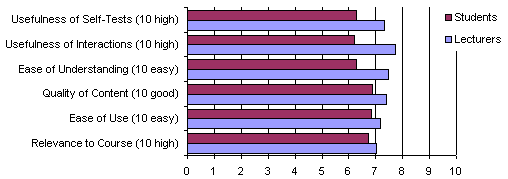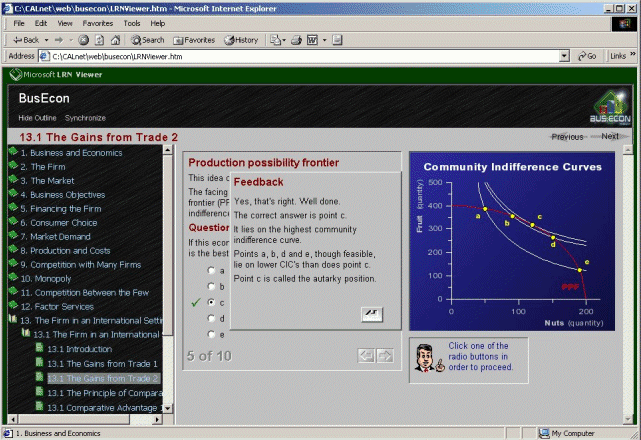Volume 15, Issue 1, 2002

Introducing BusEcon: Courseware for Business Economics developed by the WinEcon II project
- Chris Elven
- London Guildhall University
- Jean Soper
- University of Leicester
- Simon Price
- University of Bristol (note)
Introduction
This paper describes the new courseware BusEcon and how the evaluation of WinEcon has informed its content and design.
The original software package WinEcon was produced by at least eight different sets of authors over a three-year period in the early 1990s. The original project benefited from a generous level of funding provided by the 4 UK funding councils through its Teaching and Learning Technology Programme (TLTP). WinEcon covered a wide area of Economics in its 25 chapters, but its broad aim was to support first-year undergraduate courses in orthodox Economics. For the last few years the WinEcon courseware has been used extensively in UK universities and around the world. Numerous evaluation studies have reported positively about WinEcon. The consensus opinion of various evaluators of WinEcon ranging from MacDonald and Shields (1998) to Pearce (2000) is that WinEcon is a resource that can enrich the learning experience. The studies have also shown that students derive more benefit from WinEcon when it is integrated into their course.
BusEcon is courseware that seeks to build on the strengths of WinEcon. It was developed as part of the WinEcon II project funded under the TLTP III programme. BusEcon aims to provide interactive computer-based materials to support courses in Business Economics both on Economics degrees and on other courses such as those in Business Studies or Accounting and Finance, which require an Economics component. It does this by emphasising those aspects of economic analysis that are of particular relevance to students on Business related degrees, and also by including a wide variety of real-world applications.
Views of WinEcon Users
Early in the BusEcon project, attempts were made to collect the views of both staff adopters and student users of WinEcon in order to inform the development of the new software. Questionnaires were posted to holders of WinEcon site licences and 32 replies were received. Of those who revealed their identity most were in UK universities, one was in a school and four were in countries outside the UK. The responses show that lecturers perceive WinEcon's strengths to be:
- Its extreme user-friendliness
- Its interactivity and visual layout
- Its theoretical rigour
- The fact that it allows students to revisit areas they find difficult
- The systematic development of graphs etc on screen
- Some excellent explanations
- The opportunities for students to 'play' with data to see the consequences of decisions
- Good self testing with explanations of why the answer is correct or incorrect
- Links to relevant material.
Questionnaires were also distributed to student users at three UK universities and 179 completed forms were received. Comments by student users on WinEcon's strengths emphasised its ease of use, clarity, presentation and depth.
All respondents were asked to rank each of 6 aspects of WinEcon on a scale from 0 to 10, where a score of 10 implied excellence. The mean rankings given by both lecturers and students are shown in Figure 1. On each aspect, the average of the lecturers' rankings is above 7 while the average of the students' rankings is above 6. The higher rankings by lecturers are to be expected, since they have all chosen to recommend WinEcon to their students while the students (who are mostly at different universities from the lecturers in the sample) have had WinEcon thrust upon them. The overall picture presented by these results is that WinEcon is highly rated by both lecturers and students.

Figure 1: Mean scores given by users to various aspects of WinEcon
The questionnaire included a question "Is there anything about WinEcon you particularly dislike?" While many people answered "No", other lecturer responses included:
- Lack of Web access
- Students can't copy text from it
- Students dislike lack of printout facility
- Students find pages slow to load
Several lecturers criticised the treatment and presentation of macroeconomic theory. One said that once you get past National Income it is very complicated, which puts students off. Another noted a disparity between the treatment of micro and macro, saying that the micro sections treat 'issues' extremely well, whilst macro's weakness lies in the failure to address specifically individual issues such as employment/unemployment, inflation, growth etc. except as part of the overall system. Students themselves mostly answered "No" to whether there was anything they particularly disliked, but WinEcon's 'slow pace' was unpopular with some. A few students said that sometimes there is too much detail, and others that there are not enough multiple choice questions.
Respondents were asked to suggest topics on which WinEcon might provide more material. Numerous people said "None - there is enough (or even too much) in WinEcon already". Others did want additional topics. Some lecturers felt they most needed material relating to the context in which their students were studying economics - for example, agriculture, leisure and tourism. Two lecturers suggested comparative advantage and exchange rates. The topic on which students most commonly requested additional material was the IS-LM model. Students said they found the WinEcon explanation more detailed than the textbook, and that this was helpful. Although there was some diversity in suggestions about changes that should be made to WinEcon, there was considerable support for a Web type interface and the inclusion of project-based topics.
BusEcon Content
The new courseware is made up of fifteen chapters, each of which includes applications and case studies. These chapters are a mixture of newly-authored screens and existing WinEcon pages. The latter have been revised and updated to incorporate feedback received and other content changes. The selection of topics is chosen to be appropriate for students on business related degrees and includes only basic macroeconomic theory. This is in response to the comments made by WinEcon users about the macroeconomic material. The chapter headings are as follows:
- An Introduction to Business and Economics
- The Firm
- The Market
- Business Objectives
- Financing the Firm
- Consumer Choice
- Market Demand
- Production and Costs
- Competition with Many Firms
- Monopoly
- Competition between the Few
- Factor Services
- The Firm in an International Setting
- Government and the Firm
- The Macroeconomy
BusEcon focuses on business-related topics from an economics perspective. It emphasises that business activity takes place within an economic system and that the nature and structure of that system greatly affect the operation of a business, its objectives and how successfully these objectives are met.
It is true, of course, that although business and economists have a common interest in how an economy works, their perspectives on it differ. Economists are centrally concerned with the performance of the economy from the point of view of, in some sense, society as a whole. Business, even if paying proper regard to ethical standards of behaviour, tends to be more narrowly focussed upon its success or failure in a particular field. Broadly speaking, BusEcon uses the economists' approach as its organising principle in its exposition of business.
For instance the early chapter 'The Firm' explores the idea of the firm and its role as the key agent of production in an economy. It considers the kinds of production that can take place within firms and what it means to say that firms add value. It also explains that not all production need take place within a firm, that a firm may arrange production so that some of it takes place 'in-house' and the rest is outsourced. Students are invited to explore the factors that affect firms' outsourcing decisions and to consider the importance of transaction costs. Thereafter students investigate the Principal-Agent problem, which, of course, is a key relationship in business, at the heart of all sorts of business problems.
The purpose of presenting such material is to invite students to investigate the nature of the firm by focussing on important economic questions and concepts. An application is provided in the screen An Example of a Modern Firm: the Lonely Planet Organisation. This draws on the Lonely Planet story of how the first guidebook was written at a kitchen table. It highlights factors that have helped Lonely Planet develop into a successful international firm that has limited company status.
The Lonely Planet application asks questions to which users are invited to respond, such as "Can only firms publish books?" It also lets students investigate how the theoretical concepts of preparedness to pay and relationship marketing can be applied, drawing on material from the Lonely Planet Web site.
BusEcon builds on the kinds of interaction developed in WinEcon. For instance interactive graphing screens are an integral part of the exposition of the international trade screens and the applications added to the chapter on consumer choice. Question and answer interactions with extensive feedback are an important teaching device used in the early chapters, such as Chapter 2, The Firm, and Chapter 4, Business Objectives.
Partly in response to the feedback questionnaires on WinEcon, a new chapter in BusEcon provides an international context for analysing the activities of firms. This chapter includes topics on comparative advantage and exchange rates that users had noted were missing from WinEcon. Students are invited to consider certain questions relating to economic aspects of international business.
- Why does trade take place at all?
- What advantages does it offer over self-sufficiency?
- How can more developed economies obtain products more cheaply from less developed ones than producing them themselves?
- Why do countries trade similar products, such as different brands of televisions or motor cars?
Later in the chapter students go on to explore some further questions relating to the international dimension:
- How are exchange rates between different currencies established and how can firms handle the risk of adverse movements in currency rates?
- What advantages arise from locating production units 'abroad'? In other words what advantages do multi-national companies have?
- Do the activities of such companies benefit the local economies in which they operate?
Again these are familiar economic questions presented in a context that makes clear their 'relevance' to business.
Students can discover how the issues analysed in these topics impact on the policies of four major international companies in the case study on Multinational Companies. BusEcon presents users with questions relating to the product mix of the companies, the impact of exchange rate changes on their profits and the ways in which the companies are structured. The material used is taken from the Web sites of the four companies, which are Nike, Procter and Gamble, HB Fuller and BP.
The Balance of Payments is another topic included in this chapter. This is taken from the original WinEcon topic of that name, but has been completely updated using current definitions. The data shown on the screen are for the UK Balance of Payments 1999. Students can investigate what the various terms mean and discover why the Balance of Payments always balances.
Technical Developments
The most important technical development between WinEcon and BusEcon is that BusEcon runs inside a Web browser. Primarily, this addresses the growing institutional requirement in UK Higher Education for teaching software to be delivered through a Managed or Virtual Learning Environments (MLE/VLE) such as Blackboard and WebCT. In many cases, migration to the Web automatically addressed student requests to be able to copy and paste content or to print pages out to include in their own notes.
The WinEcon II project stressed the importance of the Web in terms of 'componentising' courseware (breaking it down into smaller learning objects) and migrating these objects towards Open Standards to facilitate integration and embedding into taught courses. Consequently BusEcon has been created as a seamless mix of repurposed and updated WinEcon pages and entirely new business economics pages, where each learning object is available and described using XML-based IMS compatible metadata (IMS 2001).
The 249 tutorial screens that make up the new BusEcon course are comprised as follows.
- 92 newly written interactive courseware pages (including circa 20 case study pages)
- 18 repurposed and updated WinEcon pages
- 139 repurposed WinEcon pages
- 157 HTML pages to present and organise the repurposed tutorial pages
The new courseware pages have been written entirely in HTML, JavaScript and JAVA and while optimised for Internet Explorer 5.5 or higher can also run in Netscape 6.2 or higher. The repurposed selection of relevant pages from the original WinEcon software run in a browser using the freely available ToolBook II Neuron plug-in which is included with the software.
BusEcon ships with a default course structure arranged into 15 chapters. As with WinEcon before it, it is possible to rearrange the topic pages that make up the chapters or to select subsets of the course. Unlike WinEcon, this rearrangement does not require the WinEcon Lecturer courseware customisation software to effect the rearrangement and selection because the topics are just ordinary HTML Web pages. Furthermore, as ordinary HTML, all the newly authored pages (and the HTML "wrapper" pages of the repurposed WinEcon ToolBook pages) can be edited down to the minutest detail using one of the numerous Web editing tools available from third-parties.
As an example of how BusEcon content can be integrated into third-party environments, BusEcon ships with a navigation structure built using Microsoft's IMS demonstrator - Learning Resource Network 2 (Microsoft 2000). Using the free LRN editor downloadable from Microsoft the BusEcon courseware can be rearranged or mixed with Word documents, PowerPoint slides, Excel Spreadsheets or any Web pages (including external ones). A screen shot of BusEcon running in LRN is shown in Figure 2.

Figure 2: BusEcon running in Microsoft's IMS compatible LRN Viewer
Being a Microsoft product, LRN only works in Internet Explorer and, without some modification, can also only be hosted on an NT or Windows 2000 server. BusEcon works around these restrictions by making an alternative navigation structure available for users of Netscape (that also works in IE too) and a patch to make LRN hostable on non-Microsoft servers.
Further details
BusEcon is published by Blackwell Publishers under similar site licence agreements to WinEcon. The software may not be placed on the open Internet but can be installed on university intranets or password protected extranets (e.g. to students via dial-up).
For further details about BusEcon, WinEcon, MathEcon or WebEcon, please visit http://www.ilrt.bris.ac.uk/winecon/
References
MacDonald, Ziggy and Mike Shields, "WinEcon: An Evaluation," Journal of Economic Surveys, 12, 1998, 221-231.
Pearce, R. (2000). Review of the Use of Selected Components of WinEcon by Wye External Programme Students, Wye College, University of London, available from http://www.webecon.bris.ac.uk/evaluation/pearce2000.doc
Microsoft, (2000) Learning Resource Network version 2 (LRN) http://www.microsoft.com/elearn/
IMS, (2001) IMS Global Learning Consortium http://www.imsglobal.org/specifications.cfm
Note
1 The authors would like to acknowledge the important contribution of Dr. Norman Thacker in the authoring and development of the BusEcon materials.

